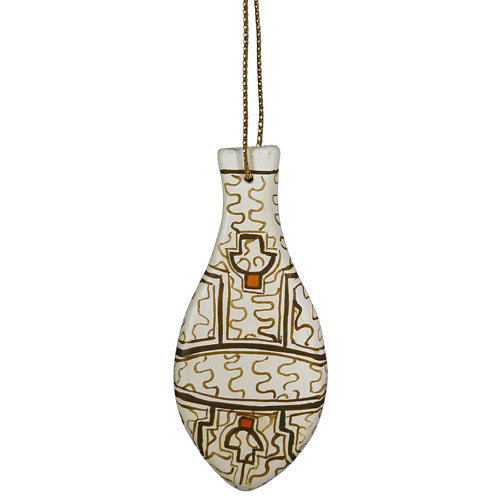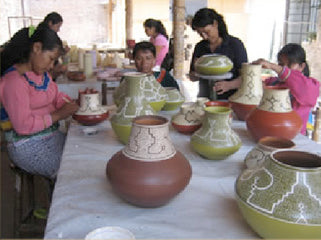OWP
Hand-Made Shipibo Ceramic Vase Ornament
Hand-Made Shipibo Ceramic Vase Ornament
Couldn't load pickup availability
Perfect for your Christmas tree or an all-year decoration, this Vase Ornament has been handmade by a member of Peru's ancient Shipibo tribe. The Shipibo are well known for their traditional ceramic arts, which are often decorated with geometric patterns inspired by their ancestral cosmology. Each pattern is unique and attributed not to the individual artisan who created it, but to the collective consciousness of the entire tribe. As such, each piece shares a traditional tale of inspiration, ancient knowledge, and collective wisdom.
- Measures approximately 3" high x 1-1/2" wide
- Decorated on both sides
- Also available as a Ball, Bell, or Set of Three
Handmade and fair trade imported from Peru.
Shipibo art is well-known for its intricate designs, yet little understood by the outside world. Some anthropologists consider the geometric patterns an ancient language form; others speculate they represent an ancient cosmology, the mapping of the Amazon rivers, or the shapes of an Anaconda. While anthropologists disagree on the exact meaning, art lovers may enjoy the elaborate design, soft curves, and the light weight of each piece, which is handcrafted without the use of pottery wheels.
Shipibo ceramics have grown more involved over time, with sophisticated patterns passing from one generation of artisans to the next. Shipibo artisans, often the women of the village, are not formally trained. Rather, they're collectively inspired to create their own distinctive patterns and work together to produce a single piece. To an observer, each woman seems moved by the same artistic spirit; one woman can interrupt her work and assign another artisan to complete that particular piece. The finished art will look like it was made by a single artist. This is communal art at its finest.
Share
About the Artisans
About the Artisans
 Joyeria Semilla meaning Seed Jewelry is a small fair-trade workshop in the Andean town of Villa de Leyva, Colombia. Girasol Taborda, a local artisan and social entrepreneur, started the workshop in the mid-1990s.
Joyeria Semilla meaning Seed Jewelry is a small fair-trade workshop in the Andean town of Villa de Leyva, Colombia. Girasol Taborda, a local artisan and social entrepreneur, started the workshop in the mid-1990s.
Joyeria Semilla’s objective is three-folds; to create new jobs, revive Colombia's handicrafts sector and to motivate locals to better manage their natural resources. The organization works primarily with socially and economically disadvantaged youths, single mothers and people with disabilities in the area. The company offers free training in product design, technical training and marketing to new members. Joyeria Semilla has trained them in the craft of jewelry-making.

Caña Flecha or “Gynerium Sagittatum” is a locally found palm tree in the regions of the Caribbean coast. The leaves from this plant are used for making jewelry, woven hats, bags and baskets. The Zenú Indians were and their descendants inherited the tradition of picking veins of the green palm leaf for weaving. These veins were made into woven hats and other products for their personal use.
The Zenú culture is said to have existed between 200BC to1600AD. With the arrival of the colonizers in the 16th century, the indigenous community declined of unknown reasons. Today a very small population remains that claims the inheritance of the almost extinct Zenú tribe. Known for their skills in the construction of major waterworks, canals and irrigation system along with being skilled goldsmiths, examples of their accomplished craftsmanship are found in various museums around the world. Their larger means of subsistence were hunting, farming, fishing and trading.
Caña Flecha is found in abundance in the region, and hence makes for a sustainable and naturally available raw material for these products. Every bit of the plant is utilized – from using in building walls and roofs in houses to food for cattle and medicinal purposes. It is from the central vein of the leaf that the fibers for weaving are obtained. After the hard surface is peeled off, the fibers are left in the sun to dry and undergo a natural tinting process; these fibers are barely about 1 millimeter in thickness and hence call for a lot of skill and patience to weave with. The dried fibers are then processed for natural coloration - some are boiled with lemon to whiten them and some are treated with mud and boiled with plantain leaves to blacken them. The designs are based on ancient motifs and mathematical representations, which are inspired by the early Zenú culture.






